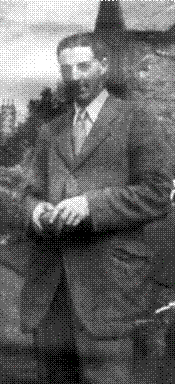Fact file:
Matriculated: 1904
Born: 20 November 1885
Died: 25 September 1915
Regiment: King’s Own Scottish Borderers
Grave/Memorial: Loos Memorial: Panels 53 to 56
Family background
b. 20 November 1885 in Edinburgh as the youngest (fourth) son of Thomas Hector Smith (1845–1917) and Lucy Smith (née Deans) (1848–1926). At the time of the 1901 Census, the family (plus seven servants) was living at 33, Drumsheugh Gardens, Edinburgh.
Parents and antecedents
Smith’s paternal grandfather, Thomas Smith (1805–89), was a corn merchant in Stonehaven, Scotland.
Smith’s father was educated at the grammar school in Aberdeen, and in May 1861, when he was 16, he started work as an apprentice in the Stonehaven branch of the National Bank of Scotland. Three years later, at the end of his apprenticeship, he moved to Edinburgh, where he worked initially as a junior teller in the George Street branch of the same bank. By the time of the 1871 Census he was working in the bank’s Inspectors’ Department, and in 1874 he became Assistant Manager of the bank’s London branch. On 24 June 1881 he was promoted Joint General Manager of the National Bank of Scotland and on 1 January 1882, at the very young age of 37, he became its sole General Manager. He worked in this capacity until his retirement at the end of 1911 and in 1897 he became President of the Institute of Bankers in Scotland for several years. A biographical sketch of 1904 described him as follows:
Truth compels the statement that he was rather of the society order. The Scottish Bankers’ Literary Association knew him not. While it was debating he was probably dancing, fencing or volunteering. But let it not be thought for a moment that he was neglecting his banking duties, for he discharged them in a cool and collected fashion, and with quite a capacity for business. His non-aggressive character helped him greatly. He always dressed in the pink of fashion. He had the faculty, too, of being susceptible and pervious to the ideas of others and of gauging their utility. He went along the line of least resistance. He made few or no enemies while he was pursuing his upward flight, whether he makes them now or not. He was courtly and deferential: he knew whom to cultivate and whom to avoid. […] of commanding height, he is of pale complexion, has a dark military moustache … broad but sloping shoulders, and large lustrous orbs.
Smith’s mother, born in Westminster, was the daughter of Thomas Deans (1802–63), a parliamentary solicitor, originally from Ayrshire.
Siblings and their families
Brother of:
(1) Thomas Philip Hector (1872–1922); married (1899) Maud Moy Thomas (b. c.1874, date of death unknown);
(2) Dugald (c.1875–1948); after 23 June 1923 (by deed poll) Dugald Smith Deans; married (1923) Sybil Brodhurst (née Hill) (1877–1936), whose first husband, Richard Wilfred Braithwaite (1877–1915) was killed in action on 31 July 1915 while serving as a Captain with the 10th Battalion, the Durham Light Infantry (no known grave);
(3) Geoffrey Herbert (later Lieutenant, RA, DSO) (1878–1910).
Thomas Philip Hector was a stockbroker and on 16 November 1915 was gazetted Second Lieutenant in the Cheshire Regiment.
Dugald worked for the National Bank of Scotland and, like his father, became the Assistant Manager of its London branch.
Geoffrey Herbert attended Trinity College, Glenalmond, Perth and Kinross, Scotland, from 1890 to 1897, and after leaving received his first commission with the Edinburgh-based 1st Mid-Lothian Royal Garrison Artillery Volunteers in August 1897. He was promoted Lieutenant (Territorial Forces) in November 1899 but joined the Regular Army (Royal Field Artillery) in the following year and went down to Second Lieutenant on 12 May 1900, only to be promoted Lieutenant once more on 1 November 1901. He went to South Africa in 1900 and served in the Imperial Yeomanry with the 78th Battery, Royal Field Artillery, throughout the Second Boer War; he was also attached to the 10th Division’s Ammunition Column. While serving in South Africa, he took part in operations in the Transvaal east of Pretoria (August and September 1900) and west of Pretoria (October 1900), in operations in Orange River Colony (July 1900), in Cape Colony (1900), and in the Transvaal (1900–31 May 1902). He was twice mentioned in dispatches by Lord Kitchener (20 August 1901 and 18 July 1902), and received the Queen’s Medal with three clasps and the King’s Medal with two clasps. On 31 October 1902 he was awarded the DSO “in recognition of services during the operations in South Africa” and, more particularly, for continuing to fight his guns, despite being severely wounded, at the Battle of Boschbult (Hart’s River) on 31 March 1902. He stayed in South Africa after the war but moved to India with the 7th Brigade in 1904, where he became a company commander in the 9th Bhopal Infantry (Indian Army) and was promoted Captain (Indian Army) on 7 May 1907. Described as “a promising young officer”, he died at Rawalpindi, India, on 23 November 1910 as a result of an accident with a revolver.
Education and professional life
Hubert Hector also attended Trinity College, Glenalmond, from 1896 to 1904, where he became a Prefect and played in the 1st cricket XI and the 1st rugby XV. He matriculated at Magdalen as a Commoner on 18 October 1904, having taken Responsions in Trinity Term 1904. He took the First Public Examination in Trinity Term and October 1905 and then read for an Honours Degree in Modern History. He was awarded a 3rd in Trinity Term 1908, and he took his BA on 26 November 1908. As he was particularly interested in literature, he worked for several years with the publishers Sidgwick & Jackson of Adam Street, London WC. President Warren called him “an excellent specimen of his country, whether in civil or military life […]. Quiet but resourceful, full of intelligence, he would have done well in life, as he did in College.” When he made his will, he gave his parents’ address at 33, Drumsheugh Gardens, Edinburgh.
According to the Census of 1911, Hubert Hector was then living at 99, St George’s Square, Pimlico, London SW1, a garden square that is considered one of the most beautiful garden squares in London.
Other residents at the same address at the time, each with a servant, included:
(1) Philip Lloyd-Greame (1884–1972), barrister, later Philip Cunliffe-Lister, 1st Earl of Swinton, GBE, CH, MC, PC; he was a prominent British Conservative politician from the 1920s until the 1950s;
(2) Henry Robert Chichester Balfour, BA (Oxon), MA (Cantab.) (1882–1964), civil servant (Home Office) and Clerk to the House of Commons;
(3) George William Chrystal (later Sir) (1880–1944), MA (Edinburgh), BA (Oxon), later CB, KCB, civil servant from 1904 to 1940 (Admiralty, Home Office, Ministry of National Service, Ministry of Reconstruction, the Demobilization Section of the War Cabinet, Ministry of Pensions, Ministry of Health); he was also a writer and translator, publishing a new translation of the Meditations of Marcus Aurelius, a translation of the Memoirs of Prince Chlodwig of Hohenlohe-Schillingsfürst, a translation of Julius Meier-Graefe’s (1867–1935) The Development of Modern Art, and, with John Sutherland Black, the first biography of William Robertson Smith (1912), plus a volume of Smith’s lectures and essays;
(4) John Sutherland Black (1846–1923), author and editor.
George William Chrystal was also the eldest son of George Chrystal (1851–1911), Professor of Mathematics at the University of Edinburgh, and both knew the Smith family via the Edinburgh connection. John Sutherland Black had also known Hubert Hector Smith for more than 20 years.


Hubert Hector Smith
(Photos courtesy of Magdalen College, Oxford)
Military and war service
Smith, who was 6 feet tall, attested for the Territorial Forces on 13 August 1914 and became a Private in ‘A’ Company of the 8th (Service) Battalion, the Royal Scots (Lothian Regiment) (Territorial Forces) that had been formed at Haddington, nine miles east of Edinburgh, on 4 August 1914. He applied for a Temporary Commission on 1 September 1914 and on 26 September 1914 he was commissioned Second Lieutenant in the 8th (Service) Battalion, the King’s Own Scottish Borderers, when it was formed at Berwick-on-Tweed. The Battalion was part of the 46th Brigade in the 15th (Scottish) Division, one of the first two of Kitchener’s newly raised divisions to be sent into battle. The Battalion then went south to the army camp at Bordon, East Hampshire, and here, on December 1914, Smith was promoted Lieutenant (London Gazette, no. 29,050, 26 January 1916, p. 802). In February 1915 the Battalion was sent to Winchester and then, in April, to Park House and Chisledon on Salisbury Plain, where Smith was promoted Captain on 12 May 1915. By the time it left Chisledon on 8 July 1915, it consisted of 36 officers and 985 other ranks (ORs).
The Battalion, including Smith, had disembarked in Boulogne by the evening of 10 July 1915, and after resting for a day it travelled by train to Zutkerque, half-way between Calais and St-Omer, whence it marched the 15 miles to Arques, on the eastern edge of St-Omer, on 15 July. The Battalion’s War Diary records: “Hot and dusty march […], very trying to the men many of whom are wearing new boots of trade pattern, which are playing havoc with the feet.” On 16 July it marched a further 14 miles south-eastwards to St-Hilaire-Cottes – “Many of the men [are] regularly done up through new boots” – where the locals were unhelpful over the matter of billets. On 17 July it marched the final six miles south-eastwards to Allouagne, where it stayed in crowded billets from 17 to 24 July. From 25 July to 3 August the Battalion was in the trenches near Allouagne, after which it marched c.11 miles south-eastwards to Mazingarbe, a south-western suburb of Béthune: “heavy marching through mud and rain”. From 10 to 14 August and 16 to 22 August the Battalion was in the trenches in the area known as Maroc, about a mile and a half to the south-west of Loos-en-Gohelle, and suffered its first fatal casualty.
Between 23 August and 2 September, the 8th Battalion was in Brigade or Divisional Reserve further over to the west and south of Béthune, at Les Brebis, Houchin and Fouquereuil, and selected officers and men were sent on specialist training courses as part of the preparations for the coming Battle of Loos (25 September–13 October 1915). From 2 to 12 September, the Battalion was back in the line at Mazingarbe – “Heavy rain all night. Men most uncomfortable” – improving the trenches under the supervision of the Royal Engineers, bringing up ammunition etc. for the coming battle, and experiencing a gradual increase in its casualties. The Battalion was away from the front from 12 to 24 September, resting and practising infantry tactics: it returned to the trenches north-east of Noeux-les-Mines on 22 September, where, on 24 September, it was issued with assault equipment – grenade launchers, billhooks, wire cutters, hedging gloves, empty sandbags, marker flags and entrenching tools. On 24 September the Battalion paraded in the village of Philosophe and marched to the assembly trenches during the night, ready for zero hour (05.30 hours) on the following day.
On 25 September 1915, the 15th Division was positioned towards the right, i.e. the southern end of the line, immediately to the north of the 47th (London) Division and almost opposite the mining village of Loos-en-Gohelle itself. The attack, which had been preceded by a heavy, 40-minute-long artillery barrage and supported by gas (which in this, the southern, sector of the battle badly affected the attacking troops), began at 06.30 hours, and despite very heavy losses, including many senior officers, Loos was captured by 08.30 hours and the north–south road from La Bassée to Lens was reached by 09.15 hours. Smith’s Battalion was in Brigade Reserve during the morning and became involved in the attack only in the mid–late afternoon, during the attempt to consolidate positions on Hill 70, a low hill with bare slopes that was enfiladed by machine-guns situated in factory buildings in the Cité Saint Auguste, a suburb of Lens that lay just to the east. As Captain H.P. Hart (later DSO), the Commanding Officer of ‘A’ Company, had been wounded in the morning by a sniper, Smith, by now a Captain and the Company’s second-in-command, took over the Company and led the attack through Loos-en-Gohelle and up to a point just south of Hill 70, despite hand-to-hand fighting and very severe fire from rifles, machine-guns, and shells. Although Smith was wounded during this fighting, he continued to issue orders quite clearly until he was wounded for the second time and killed in action, aged 29, one of the Battalion’s 14 officers and 400 ORs who were killed, wounded or missing during the assault, which failed to reach the final objective, the Cité Saint Auguste. Smith met his death about three miles south of where C.T. Mills would be killed in action 11 days later. He has no known grave. He is commemorated on Panels 53–56 of the Loos Memorial. He left £757 0s. 5d.
Bibliography
For the books and archives referred to here in short form, refer to the Slow Dusk Bibliography and Archival Sources.
Printed sources:
[Anon.], ‘Fatal Accident to Officer in India: A Native of Edinburgh’, The Scotsman (Edinburgh), no. 21,052 (29 November 1910), p. 10.
[Thomas Herbert Warren], ‘Oxford’s Sacrifice’ [obituary], The Oxford Magazine, 34, extra number (5 November 1915), p. 17.
Hart and Goss (1920); digitized version (2007), pp. 29–34.
De Ruvigny’s Roll of Honour, 1914–1919, vol. 2, pp. 278–9.
Warner (2000), pp. 7–15.
Archival sources:
MCA: Ms. 876 (III), vol. 3.
OUA: UR 2/1/55.
WO95/1953.
WO339/14859.
